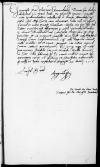List #121
Ioannes DANTISCUS do Sigmund von HERBERSTEINAugsburg, 1516-11-21
Rękopiśmienne podstawy źródłowe:
Publikacje:
| ||||||
Tekst + aparat krytyczny + komentarzZwykły tekstTekst + komentarzTekst + aparat krytyczny
Generoso et strenuo domino
Generose Domine, plurimam commendationem.
Ternas his diebus dedi ad Generositatem Vestram litteras[1], ex quibus, ut opinor, mentem meam abundanter intellexit etc. Accepi mandatum
Eiusdem Generositatis Vestrae obsequentissimus


 ONB, Cod. 13.597, f. 17v
ONB, Cod. 13.597, f. 17v